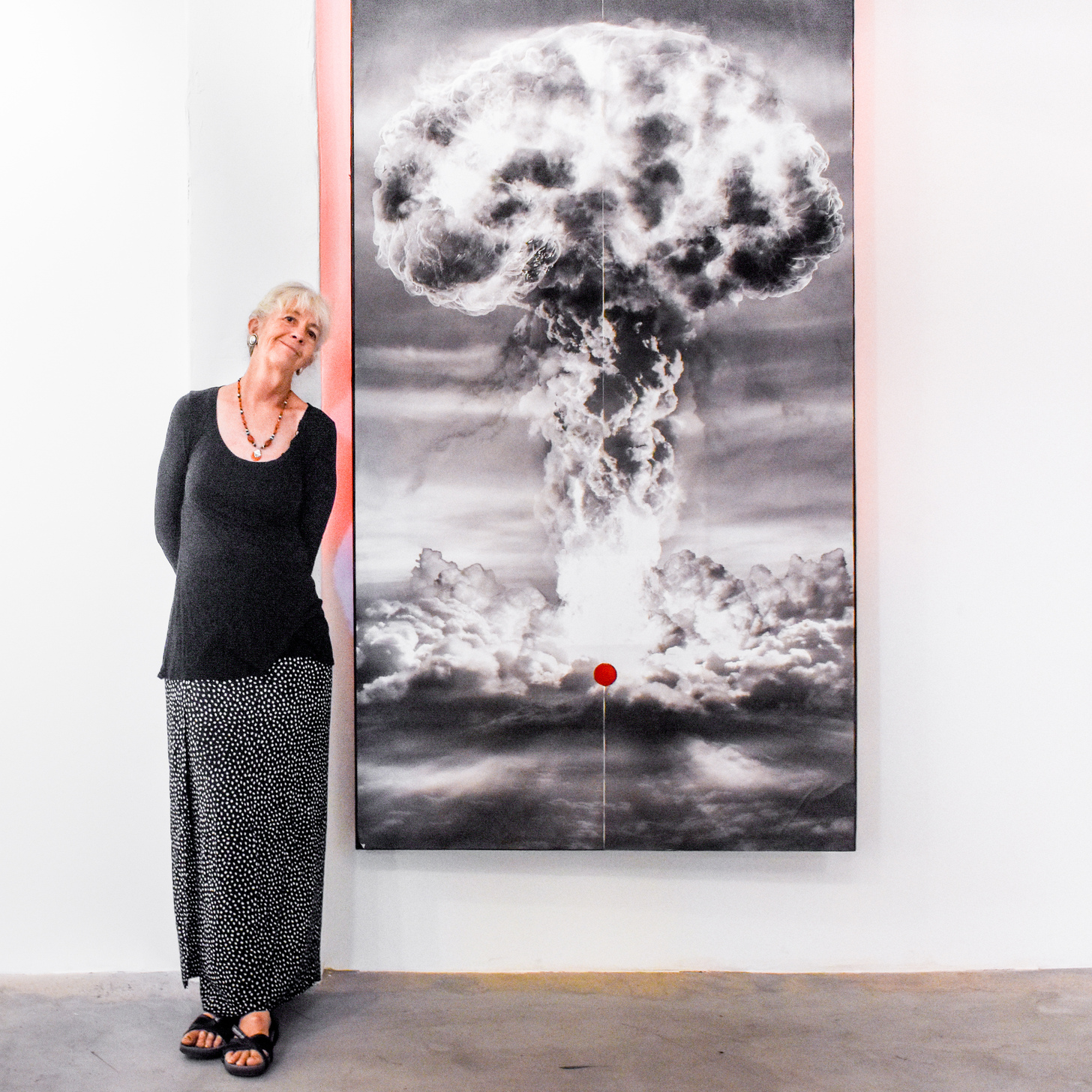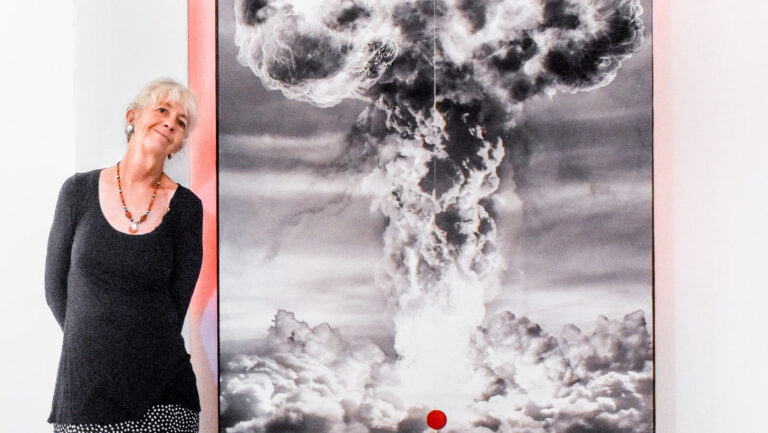When it is quiet in the gallery, you can hear the Geiger counter in the room note each decaying radioactive particle. With predictable precision, time likewise rounds off the edges of our actions. The energy brought to what we did slowly fades, losing detail and perspectives as news turns into history. As people die off, and with them any memories not memorialized, the narrative becomes inert. The history of nuclear power, nuclear weapons, nuclear contamination and the full-scale horror of nuclear devastation passes into a sleepy oblivion wrapped up in a simple story about good and bad. Nuclear history began here in New Mexico and curator Barbara Grothus thinks it’s not that simple.There are stories in the exhibit Black Hole/Atomic City (State of Decay) that are outside the narrative told by the scientists, profiteers, generals and military historians. There are stories about the people of New Mexico, what they saw and what they felt. Grothus believes we need to hear more of these stories, lest they be lost to the decaying narrative of history. Weekly Alibi spoke with Barbara Grothus about the nuclear business, nuclear disarmament and the stories that aren’t being told about our nuclear history here in New Mexico. The following is an edited version of that conversation.Weekly Alibi: The first question is—War. What is it good for?Barbara Grothus: It has been good for the New Mexico economy. Los Alamos has a big economic footprint. It impacts other industries and it’s been very good for certain people in our state. What do you want people to take away from this exhibit?Next year is the 75th anniversary of the first nuclear explosions, and the only nuclear explosions on people and places that were intentional. They have been telling their story for 75 years. They saved the world from World War II; from the Japanese; from the Germans, by being the first to demonstrate the terrible consequences of bad behavior as international actors. That is basically the story they have been telling for 75 years and they have never really acknowledged any other story. I grew up there [in Los Alamos]. My father was an anti-nuclear activist there. He was extremely well known for it because he was the only person who was really speaking out about it for 30 years. My father has now been dead for a little over 10 years. It seemed to me that it was important to try to focus on the impacts of the nuclear business on the people, the land, the air and the water of New Mexico. We have been trying to hear the stories, and people have been trying to tell their stories, for generations now. It would be good if we had those stories in a little bit more prominence by next year so I visualize this as being the push for getting some of that out into the world in a different way. I’m sure, obviously, there a lot of artists who are dealing with the nuclear issue, but this is maybe the first of a number of activities that happen with artists in this year coming up. There has been a controversy about when the Anthropocene started. Do you start it at the Trinity test?That’s a really interesting question. Obviously, I’m not a scientist, but I think it is a fairly compelling narrative in the sense that it really was a game changer that we could destroy the Earth. The chance that they took not really knowing. These people were theoretical physicists and they had an idea what would happen, but they considered the possibility that the entire atmosphere would burn. They took that chance and of course it didn’t happen, but the impact was large on the civilian population. The massive amount of destruction that happen in Hiroshima and Nagasaki with not just the built environment, but all the people, maybe up to a quarter of a million people, that died then or later directly as a result of those bombs. That was a game changer to have that level of destructive capability. Of course, now we’re facing not just the potential of nuclear disaster, but actually the collapse of nature by our behavior. It’s a daunting reality.Do we have any credibility asking for North Korea’s nuclear disarmament without considering our own?One of the little coinkydinks that happened with the opening of this exhibition was that August 2nd was the last day of the [Intermediate-Range Nuclear Forces] Treaty that was negotiated between [Soviet General Secretary Mikhail] Gorbachev and [U.S. President Ronald] Reagan. It came to an end because our country was no longer going to honor it. It was a day or two before when the Russians went ahead and did a missile test basically just saying, “Well, it’s over anyway. Let’s have at it.” It’s very concerning. I don’t think the United States has any credibility on these issues. Who has credibility? If I don’t put my money where my mouth is, what good is my word? If I can’t live up to my word, then how am I going to be trusted?This exhibit has several stories about the impact of 75 years of nuclear technology. What stories did you want to tell in this exhibit?I really was not going to try to tell any of the stories myself. My intention was to try to invite people who really had not had their stories told. Some of the artists have told those stories on behalf of other people. Maybe they are trying a little bit to have voices heard that they are familiar with. Not everybody is an artist. Not everybody is comfortable making work for a show like this, but I think it is fairly exciting that the artists that came to participate in this really have told some compelling stories from the history of the nuclear business. Whether it’s mining, milling, nuclear accidents, exposures of different kinds, the horror of it or the long-lasting effects, I really think a lot of stories are being told here and I didn’t direct any of it, really. The only thing I tried to do was ask people, “Why do you want to be in the show?” In the last 75 years, do you think that we have gotten smarter as a people?What does smarter mean? Does it mean we’ve increased our compassion? Does it mean we’ve learned from our mistakes? Does it mean we’ve acknowledged our behavior? I don’t even know what to say. I think people are brilliant. Our hearts are brilliant. Our minds and our spirits are brilliant. But whether or not we’re able to bring that brilliance to the fore in what seems to me to be a pretty dark time is a hard call. I want to believe that we can rise to any occasion as humanity, but it seems to be daunting.
Black Hole/Atomic City (State of Decay)
Sanitary Tortilla Factory401 Second Street SWOn Exhibit Through Aug. 30










